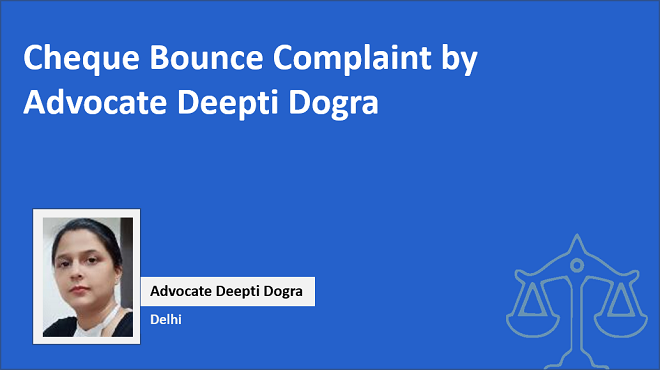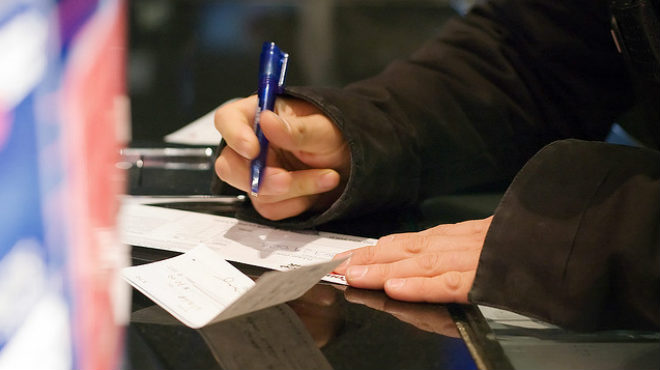How to File a Cheque Bounce Case
April 03, 2024 हिंदी में पढ़ेंTable of Contents
- How to file a Cheque Bounce case?
- Sending a Demand Notice:
- The following information should be stated clearly in the demand notice:
- Drafting a Complaint:
- Payment of Court Process fees for filing a Cheque Bounce case
- Court Notice to Accused
- Evidence
- Punishment and Penalty
- Cheque Bounce Case Procedure
- Important things to be kept in mind
- How can a lawyer help you in the process?
- FAQs
Cheque bounce cases can be complex legal matters, but with the right guidance, navigating through them can be manageable. In this article, we provide a concise step-by-step guide on how to file a cheque bounce case effectively. LawRato also provides free advice on cheque bounce matters from top lawyers in India that you can refer to.
How to file a Cheque Bounce case?
Cheque bounce is covered under section 138 of the Negotiable Instruments Act as a criminal offence, which provides the punishment for the return of a cheque by the bank after being presented for payment due to insufficient funds or for other reasons . The following information will act as a useful guide on cheque bounce case procedure:
Sending a Demand Notice:
Once the cheque has been returned by the bank, then before filing a legal complaint against the drawer, you must, with the help of a cheque bounce lawyer , first, send a demand letter/ legal notice to the such drawer within a period of 30 days from the date the cheque has been returned to you by the bank. The letter must demand the amount from the drawer and also the legal action that can be initiated against him under the Negotiable Instruments Act in case the amount is not paid within a stipulated time period (usually 15 days). Even though there is no prescribed format for this notice, its purpose of demanding payment and informing the issuer that s/he will be prosecuted in case payment is not made should be highlighted very clearly. Further, proof of delivery of such a letter should be preserved carefully. A demand letter can be sent by the complainant himself. However, it is advisable to get the draft vetted by a cheque bounce lawyer before sending it to the person concerned.
The following information should be stated clearly in the demand notice:
-
A statement that the cheque was presented within its period of validity
-
Statement of debt or legally enforceable liability
-
Information regarding dishonour of cheque as given by the bank
-
Demanding the issuer to pay the amount due within 15 days of receiving such notice
Drafting a Complaint:
If the drawer has not replied to your demand notice within a period of 15 days from the date of the delivery of the demand letter or has refused to pay your amount, then the next option available in such a case is to file a complaint in court within a stipulated time period of 30 days. Before filing a legal complaint, it is important to understand which court you should approach in such cases. You can file the complaint in a court within whose local limits of jurisdiction any of the following incidents have taken place:
-
Where the cheque was drawn
-
Where the cheque was presented
-
Where the cheque was returned by the bank
-
Where the demand notice was served by you
-
You must have all the following documents:
-
Complaint
-
Oath letter
-
Photocopy of all the documents, such as cheques, memos, notice copies, and acknowledgement receipts
Payment of Court Process fees for filing a Cheque Bounce case
While filing a cheque bounce complaint, the complainant is required to pay court fees. The Court fees vary depending upon the amount of the cheque against which the complaint is being filed. The requisite court fees for various cheque amounts have been listed below: Amount on cheque Court fee Rs. 0 to Rs. 50,000/- Rs. 200 Rs. 50,000/- to Rs. 2,00,000/- Rs. 500 Above Rs. 2,00,000/- Rs. 1000
Court Notice to Accused
After the complaint is filed by the payee, the court issues a summons to the accused person who owes the money to the person who filed the complaint.
Evidence
The Complainant, with the help of his/her cheque bounce lawyer puts forward all the evidence like the original bounced Cheque, Cheque Return Memo, Record of sending a demand notice to the accused, and all other relevant documents in support of his/her case to prove that accused is under a legal obligation to pay the stated amount in the bounced cheque.
Punishment and Penalty
Firstly, the bank may levy certain charges on account of cheque bouncing, and such charges may differ depending upon the bank. After the whole trial process, if found guilty, the accused can be punished with a monetary penalty, which may be double the amount of the cheque, imprisonment for up to 2 years, or both.
Cheque Bounce Case Procedure
-
After the case is filed in the court, all documents are cross-checked by Judicial Magistrate First Class, so original documents such as original cheque (bounced), original memo, a copy of the notice, receipt of the post office, receipt of U.P.C., acknowledgement receipt, are required at the time of cross-checking
-
The period of limitation is also verified at this stage
-
The Process Form, also known as the Bhatta, is filed by the complainant or lawyer, along with the address of the accused
-
The court then issues summons to the accused to appear in court on the specific date
-
If the accused does not appear in court on the date of the hearing, the court can also issue a bailable warrant at the request of the complainant
-
If the accused still does not appear before the court, the court may issue a non-bailable warrant of arrest
Important things to be kept in mind
-
A delay over 30 days in filing the complaint may be excused by the magistrate only in exceptional circumstances
-
Section 138 of the NI Act covers the dishonour of a cheque due to stop payment.
-
The subsequent dishonour of the cheque after presenting the cheque at the drawer's request does not increase the time limit for the drawer under the notice.
-
Section 138 of the Act does not apply to cheques issued as gifts, donations, or any other non-legal obligations for the section to be applicable, the cheque must involve a legal obligation
-
A cheque expires after three months from the date on which it is issued
Please note that the law surrounding punishment for check bouncing is becoming stringent. The latest Supreme Court judgment on a cheque bounce case of Satish P. Bhatt Vs. The State of Maharashtra & Anr. took a firm stance against repeated defaults in financial obligations, ordering two individuals to surrender within a month for serving their ten-month jail term in a 16-year-old cheque-bounce case. Additionally, the court imposed a penalty of INR 5 lakh on the company's chairman-cum-managing director and vice-chairman, stating that this penalty is separate from the compensation awarded to the complainant. There also have been recent amendments to the NI Act attempting to reduce the delay in cheque bounce matters. To know more about the amendments, you may refer to LawRato's article “ New Laws for Cheque Bounce in India”
How can a lawyer help you in the process?
A lawyer having a significant amount of experience in the field of cheque bounce issues can be of great help if you are facing dishonor of cheques. An experienced cheque bounce attorney can ensure that you have made a strong case when you are filing or defending a cheque bounce complaint. He can take care of all the paperwork and can help you understand all the complexities of a cheque bounce case. He can draft and send, on your behalf, a legal notice or a reply to a legal notice in case of dishonour of a cheque and can track the limitation period for your case so that you do not suffer any legal damage. Thus, a cheque bounce attorney can help you throughout your legal journey, can ensure low chances of failure in your cheque bounce case, and can also tell you how to escape from a cheque bounce case. You can also use LawRato's free legal advice service to get free advice on your legal issues from expert cheque bounce lawyers. Additionally, to learn more about cheque bouncing in India, you may refer to LawRato's Cheque Bounce Law Guide
FAQs
1. What are the documents required for filing of cheque bounce case and the process thereof?
The basic documents include the bounced cheque itself, the cheque-returning memo, proof of sending a legal notice to the drawer, and evidence of the notice's delivery. The first step is to send a legal notice to the drawer, and if the payment is not made within the required time, a case can be filed in court.
2. What is the time frame for filing a cheque bounce case?
The Cheque bounce case time limit allows a cheque bounce case to be initiated within 30 days from the date the drawer of the cheque receives the legal notice.
3. Is cheque bounce a punishable offence?
It is a criminal offence punishable by imprisonment for a term that may extend to two years, a fine that may extend to twice the amount of the cheque, or both.
4. Are there any circumstances when bouncing of cheque is not an offence?
Yes, these include circumstances where (i) the cheque is as an advance payment or given as security, (ii) there are discrepancies between written and numerical amounts, (iii) there are alterations on the cheque requiring the drawer's attestation, (iv)the cheque is damaged, or (v)it is issued as a gift or donation to a charitable trust.
These guides are not legal advice, nor a substitute for a lawyer
These articles are provided freely as general guides. While we do our best
to make sure these guides are helpful, we do not give any guarantee that
they are accurate or appropriate to your situation, or take any
responsibility for any loss their use might cause you. Do not rely on
information provided here without seeking experienced legal advice first. If
in doubt, please always consult a lawyer.
The internet is not a lawyer and neither are you.
Talk
to a real lawyer about your legal issue.

Comments by Users
No Comments! Be the first one to comment.
Related Articles
- Cheque Bounce Case
- Rights in Cheque Bounce Case
- How to File a Cheque Bounce Case
- Time Limit for Filing Cheque Bounce Case
- Punishment for Cheque Bounce Case
- Notice Period for Cheque Bounce
- What is Security Cheque
- Court Fees for Cheque Bounce Case
- Bail in Cheque Bounce Case
- What is Cheque bounce in India?
- New Cheque Bounce Laws in India
Cheque Bounce Law Articles
User Reviews
Easy to understand. All details covered regarding cheque bounce.
I want to hire a cheque bounce advocate. Who to call?
can I file civil and criminal case both in cheque bounce?
thanks for the details. Very helpful for my cheque bounce case.
Cheque given as security for loan? What to do?
I want to know more about this law. Good work
I have legal query. Who can I call?
nice work. Learned a lot. Thanks
Detailed and informative.
good work
good article. Please provide more info
great advice. Thanks
needed a lawyer….what is the procedure?
The article is written ver well. Learned a lot about my case through this.
good article. Can you give some more detail on the issue.
thanks for the advice
A well written article.
Written plainly to be understood by anyone who is from a non-legal background.
Very good work with the article. Gave a nice clarity about the subject.
good article. Can you share more detail
nice one. Please share more info
nice article
who can I contact for my legal case?
VIEW ALL


 619+ Lawyers are online
619+ Lawyers are online 










